February
2019
February 5, 2019
NASAA News and Current Information
New Arts Advocacy Resources from NASAA
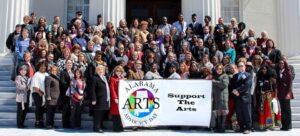 NASAA has released three advocacy resources designed to boost your efforts as an advocate for public funding for the arts:
NASAA has released three advocacy resources designed to boost your efforts as an advocate for public funding for the arts:
As NASAA President and CEO Pam Breaux explains, there’s no time like the present to get the lowdown on effective advocacy practices. NASAA’s advocacy resources will help you make the case with confidence!
FY2019 State Arts Agency Revenues Report
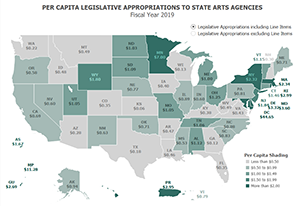 Total legislative appropriations to state arts agencies increased by 2.1% between fiscal years 2018 and 2019, according to NASAA’s FY2019 State Arts Agency Revenues report. The just-released report details appropriations and revenues to state arts agencies within the context of national trends. In addition to the report, a series of interactive dashboards drill down into individual state arts agency revenue data for FY2019, trends over the last decade and comparisons by region.
Total legislative appropriations to state arts agencies increased by 2.1% between fiscal years 2018 and 2019, according to NASAA’s FY2019 State Arts Agency Revenues report. The just-released report details appropriations and revenues to state arts agencies within the context of national trends. In addition to the report, a series of interactive dashboards drill down into individual state arts agency revenue data for FY2019, trends over the last decade and comparisons by region.
NASAA Web Seminar: Florida Arts & Wellbeing Indicators
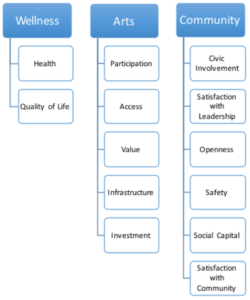 On February 28 at 3:00 p.m. Eastern, join NASAA and members of the Florida Division of Cultural Affairs and the University of Florida Center for Arts in Medicine to learn more about their Arts & Wellbeing Indicators project, a new paradigm for measuring associations between arts participation and well-being at the community level. (See this January State to State article for more.) Registration is free for all state arts agency (SAA) staff and council members. SAA staff and council members may participate in the seminar from your agency office, another workplace, your home, or anywhere else you have access to a computer and phone line. To register, use our web seminar registration form.
On February 28 at 3:00 p.m. Eastern, join NASAA and members of the Florida Division of Cultural Affairs and the University of Florida Center for Arts in Medicine to learn more about their Arts & Wellbeing Indicators project, a new paradigm for measuring associations between arts participation and well-being at the community level. (See this January State to State article for more.) Registration is free for all state arts agency (SAA) staff and council members. SAA staff and council members may participate in the seminar from your agency office, another workplace, your home, or anywhere else you have access to a computer and phone line. To register, use our web seminar registration form.
Thank You—We Did It!
Thanks to your amazing generosity, our 50 Years, 50 Ways NASAA Makes a Difference campaign was a success! Hundreds of you contributed to help NASAA raise $50,000 in honor of our golden anniversary. Your support helps us do even more for you, especially as we work to safeguard the National Endowment for the Arts, produce the customized research you need to make the most convincing case for public support of the arts, and deliver the learning services, insight and perspective that keep you on top of your game! Together, through the arts, we make a positive difference for people every day in every corner of the country. We’re so proud to be doing this work, and your support means the world. Thank you!
Evaluating Museum Accessibility
A new paper from the Institute of Museum and Library Services and the Association of Children’s Museums evaluates their joint initiative to encourage people of all backgrounds to visit museums regularly and to build lifelong museum habits. Museums for All Evaluation Report summarizes an in-depth program assessment designed to determine the initiative’s impacts on both communities and museums’ operations. The paper, which is based on a survey of and interviews with museums participating in the initiative, could be a resource for state arts agencies thinking about launching a program evaluation.
Equity Resources for Local Arts Agencies
In a new report, Equitable Investment Policies and Practices in the Local Arts Field, Americans for the Arts (AFTA) addresses how, when and where local arts agencies (LAAs) consider equity in the deployment of their funds, time, space and staff. Based on the results from the 2018 iteration of AFTA’s annual Local Arts Agency Profile, the paper concludes that LAAs are committed to increasing equity in their policies and practices. There remain, however, many improvements to be made regarding fiscal decision making, professional development and grant making. In a related document, Strategies to Achieve Equitable Investment by Local Arts Agencies and Nexus Organizations, AFTA offers a set of policy and practice recommendations for fostering meaningful and measurable progress toward fair and equitable distribution of LAA investments.
New Creative Placemaking Resources
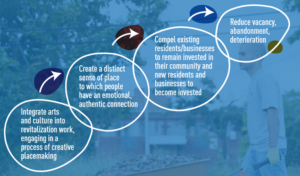 There are two new creative placemaking resources. The first, Creative Placemaking on Vacant Properties, is a primer on the practice and its role in revitalizing distressed communities. The paper, by the Center for Community Progress and Metris Arts Consulting, features case studies about four communities repurposing and revitalizing vacant properties through arts and culture. The Kresge Foundation’s Creative Placemaking: Rethinking Neighborhood Change and Tracking Progress, meanwhile, considers the experiences of its creative placemaking grantees in San Francisco, New Orleans and Minneapolis and offers insights drawn from them. The paper explores more thoroughly some of the issues the foundation has addressed in its previous publications on creative placemaking, such as the need to better understand urban inequality and the need to better align research and evaluation strategies with creative placemaking practices.
There are two new creative placemaking resources. The first, Creative Placemaking on Vacant Properties, is a primer on the practice and its role in revitalizing distressed communities. The paper, by the Center for Community Progress and Metris Arts Consulting, features case studies about four communities repurposing and revitalizing vacant properties through arts and culture. The Kresge Foundation’s Creative Placemaking: Rethinking Neighborhood Change and Tracking Progress, meanwhile, considers the experiences of its creative placemaking grantees in San Francisco, New Orleans and Minneapolis and offers insights drawn from them. The paper explores more thoroughly some of the issues the foundation has addressed in its previous publications on creative placemaking, such as the need to better understand urban inequality and the need to better align research and evaluation strategies with creative placemaking practices.
Worldwide Creative Industries Trends
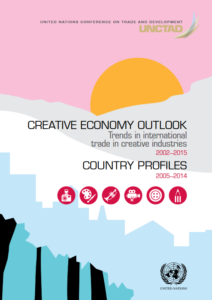 The U.N. Conference on Trade and Development has released Creative Economy Outlook, a worldwide report on creative industry trends from 2002 to 2015. Using the Harmonized Commodity Description and Coding System to classify creative goods and services, the report synthesizes data from 130 countries to outline global developments for creative trade and provides individual profiles for every reporting nation, territory and nonstate entity. The report finds that creation, production and distribution of creative goods grew at an average annual rate of 7.3% within the last decade and a half.
The U.N. Conference on Trade and Development has released Creative Economy Outlook, a worldwide report on creative industry trends from 2002 to 2015. Using the Harmonized Commodity Description and Coding System to classify creative goods and services, the report synthesizes data from 130 countries to outline global developments for creative trade and provides individual profiles for every reporting nation, territory and nonstate entity. The report finds that creation, production and distribution of creative goods grew at an average annual rate of 7.3% within the last decade and a half.
How ESSA Has Impacted Arts Education
A new paper commissioned by The Wallace Foundation, Review of Evidence: Arts Education through the Lens of ESSA, measures the impact of the 2015 federal Every Student Succeeds Act (ESSA) on arts education. Specifically, it assesses the effectiveness of arts education interventions relative to the parameters set forth in ESSA. The report concludes with a set of recommendations for practitioners and policymakers and another set for researchers.
Ken May to Depart South Carolina Arts Commission
 Ken May will retire in June as executive director of the South Carolina Arts Commission (SCAC) after 33 years working to improve equity in and access to the state’s arts, culture and traditions. As executive director for the past nine years, May led the Arts Commission’s efforts to provide equal access to publicly funded grants and programs. Under his leadership, SCAC earned bipartisan support and is widely considered a driver of the state’s $9.7 billion creative economy. Throughout his tenure at the Arts Commission, May played a key role in shaping the agency’s signature programs and initiatives. He was one of the principal architects of the Arts in Basic Curriculum Project, which has driven statewide improvement in arts education for all students for more than 30 years; he continues as the longest-serving member of that project’s coordinating committee. As primary grant writer for the Commission, May designed and secured funding for major initiatives to use the arts for rural community development, enhance community design, build public participation in the arts and help artists build sustainable working lives in South Carolina. He led long-range planning and directed agency efforts to bring grant making into the digital age and to make grant processes more transparent and equitable. May serves on the boards of NASAA, Grantmakers in the Arts and South Arts. A nationwide search is under way for his successor.
Ken May will retire in June as executive director of the South Carolina Arts Commission (SCAC) after 33 years working to improve equity in and access to the state’s arts, culture and traditions. As executive director for the past nine years, May led the Arts Commission’s efforts to provide equal access to publicly funded grants and programs. Under his leadership, SCAC earned bipartisan support and is widely considered a driver of the state’s $9.7 billion creative economy. Throughout his tenure at the Arts Commission, May played a key role in shaping the agency’s signature programs and initiatives. He was one of the principal architects of the Arts in Basic Curriculum Project, which has driven statewide improvement in arts education for all students for more than 30 years; he continues as the longest-serving member of that project’s coordinating committee. As primary grant writer for the Commission, May designed and secured funding for major initiatives to use the arts for rural community development, enhance community design, build public participation in the arts and help artists build sustainable working lives in South Carolina. He led long-range planning and directed agency efforts to bring grant making into the digital age and to make grant processes more transparent and equitable. May serves on the boards of NASAA, Grantmakers in the Arts and South Arts. A nationwide search is under way for his successor.
In this Issue
From the President and CEO
State to State
Legislative Update
Announcements and Resources
More Notes from NASAA
Research on Demand
SubscribeSubscribe
×
To receive information regarding updates to our newslettter. Please fill out the form below.
